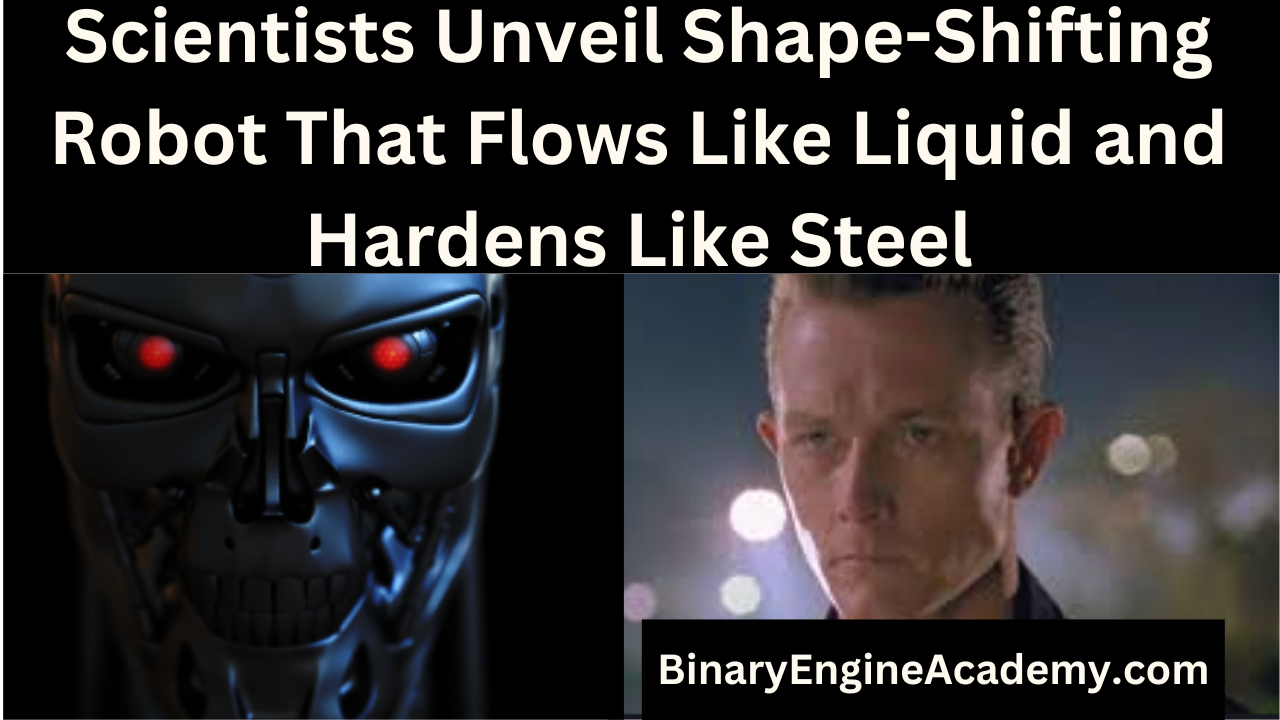Scientists Unveil Shape-Shifting Robot That Flows Like Liquid and Hardens Like Steel

In a groundbreaking advancement in robotics, scientists have unveiled a shape-shifting robot that can flow like a liquid and harden like steel. This futuristic technology, which once seemed like something out of a science fiction movie, is now a reality and could revolutionize industries across the globe. Imagine a robot that can adapt to its surroundings, squeeze through tight spaces, and instantly transform its structure to become strong and rigid when needed. This extraordinary innovation is poised to change the way we think about machines and their capabilities.
The Science Behind the Shape-Shifting Robot
At the core of this revolutionary robot is a fascinating combination of materials science, advanced engineering, and artificial intelligence. The robot is made from a special blend of materials that allows it to change its state based on external stimuli. When it’s time to flow and fit into tight spaces, the robot’s internal structure becomes soft and liquid-like. But when it needs to become strong, rigid, or perform precise tasks, it instantly hardens to the toughness of steel.
This ability to switch between two distinct forms is made possible through a complex system of smart materials and actuators that respond to environmental changes or commands from the robot’s AI brain. The liquid-like form allows the robot to be incredibly flexible and adaptable, while the hardened steel-like state offers unparalleled strength and resilience.
Key Features of the Shape-Shifting Robot:
- Liquid Flow: The robot can flow like a liquid, slipping into tight spaces or navigating complex environments.
- Steel Hardening: It can quickly harden its structure, becoming as tough as steel to handle high-impact tasks.
- Adaptive Intelligence: Equipped with AI, the robot can analyze and adapt to its surroundings in real-time.
- Durability and Precision: When hardened, the robot can withstand heavy loads and perform delicate, high-precision tasks.
Potential Applications of the Shape-Shifting Robot
The applications for a robot with the ability to flow and harden are immense, and its potential impact spans across various industries, from medical technology to manufacturing. Here are just a few of the exciting possibilities:
1. Medical Field
In medicine, this robot could be used to perform surgeries in tight or hard-to-reach areas of the body. Its liquid-like form could allow it to squeeze through blood vessels or narrow passages, while its hardened state could allow it to deliver precise surgical movements. Additionally, the robot could be used to retrieve foreign objects from a patient’s body or perform delicate operations in environments that are otherwise inaccessible for traditional surgical tools.
2. Search and Rescue
Imagine a robot that can navigate collapsed buildings or debris, flowing through cracks and spaces to reach trapped survivors. In emergencies, this robot could transform its structure to become more rigid when lifting or moving obstacles to free individuals. Its versatility could save lives in disaster scenarios where time is of the essence.
3. Space Exploration
Exploring other planets often involves navigating environments that are unpredictable and difficult to maneuver through. This robot could flow into small crevices or caves on Mars or other celestial bodies, allowing scientists to gather information or even repair equipment in environments where humans would struggle to operate. Its ability to adapt to different terrains could make space exploration more efficient and effective.
4. Manufacturing and Construction
In the world of manufacturing, robots are already playing an important role, but this shape-shifting innovation could take things to the next level. Robots like this could easily adapt to work in various environments, from delicate assembly lines to high-pressure tasks like lifting and constructing large structures. The robot could flow into intricate machinery to make repairs or adjustments and harden up to become a powerful assistant for heavy lifting.
5. Environmental Cleanup
This robot’s ability to change form could make it perfect for environmental cleanup tasks, especially in areas with hazardous waste or pollution. It could flow into tight or hazardous spaces to remove contaminants and then harden to handle the disposal or safe transportation of these materials. Its flexibility could prove essential in cleaning areas where traditional methods fail.
How It Works: The Technology Behind the Robot
The key to this robot’s incredible abilities lies in the materials used to construct it. The robot incorporates “soft” materials that can respond to heat, electrical signals, or magnetic fields, causing it to change shape on command. The transition from liquid-like to hardened forms is made possible by the interplay of these materials with intelligent control systems that coordinate the robot’s movements and actions.
Researchers have been experimenting with these types of “smart” materials for years, but the breakthrough came when they managed to combine them with AI algorithms. The AI is capable of making real-time decisions, allowing the robot to seamlessly transition between forms based on the task at hand. This combination of materials and AI makes the robot not only highly adaptable but also efficient and precise in its actions.
The Future of Robotics: A New Era
This shape-shifting robot represents just the beginning of a new era in robotics. With the ability to flow and harden at will, the possibilities are virtually endless. As this technology matures, we can expect even more sophisticated robots that can tackle complex tasks in ways we never thought possible.
Beyond its physical capabilities, the robot’s AI will continue to evolve, making it smarter and more intuitive as it interacts with its environment. We may soon see robots like these working alongside humans, helping to solve problems in ways that were once only imagined in science fiction.
Ethical and Practical Considerations
As with all emerging technologies, the advent of such powerful robots raises ethical and practical questions. How will we regulate their use? What are the potential risks associated with such adaptable robots? It’s essential to address these concerns as the technology moves forward to ensure that it benefits society without compromising safety or ethics.
Conclusion: Embracing the Future of Robotics
The creation of a robot that can flow like liquid and harden like steel is one of the most exciting developments in robotics in recent years. With its potential to revolutionize industries ranging from medicine to manufacturing, this technology could change the way we work, live, and interact with machines. The future is indeed bright, as we continue to explore the incredible possibilities that AI, materials science, and robotics hold. This is just the beginning of a new era of innovation, where shape-shifting robots could become an integral part of our daily lives.
Stay tuned, because the future of robotics has just begun to unfold.




















